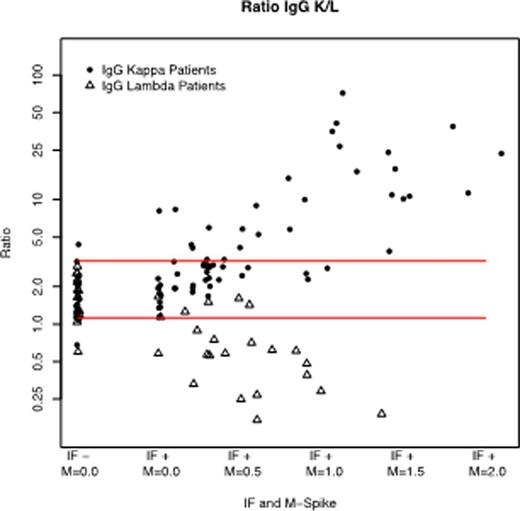Abstract
Background: TheHevylite assay (HLC Assay) is a novel assay using antibodies that recognize unique conformational epitopes presented by the association of the heavy and light chain constant regions of intact immunoglobulins (Ig) allowing quantitative measurement of each Ig class concentration and generating ratios for each pair (e.g. IgGK/IgGL). Recent studies indicate that HLC Assay can enhance the ability to detect and quantify monoclonal Ig, potentially providing greater sensitivity for detection of minimal residual disease or early relapse after treatment and providing a prognostic indicator of progression free survival (Ludwig, H. et al. Leukemia (2013) 27, 213-219; Kraj, M. et al. Adv Clin Exp Med 2014, 23, 1, 127-133). While HLC Assay could simplify and enhance the assessment of monoclonal protein response in multiple myeloma (MM), its utility as compared to standard assays (SA) (Serum Protein Electrophoresis (SPEP) and Immunofixation (IF)) is not well established. The goal of this retrospective study was to compare the performance of these tests in patients with MM seen at Memorial Sloan Kettering Cancer Center.
Methods: We have previously reported on the patterns of relapse and/or progression (R/POD) in 179 patients with MM transplanted between 2001 and 2009 at MSKCC and determined the precise date of R/POD based on IMWG standard clinical criteria using serum and urine PEP and IF, as well as Free Light Chain Assay (FLCA) (Zamarin, Bone Marrow Transplant, 2013). Serum samples from 63 of these patients, collected at the time of R/POD and/or at time points preceding R/POD were analyzed by HLC Assay and compared to results obtained by SA.
Results: Among the 63 patients, 22 had IgA and 41 had IgG isotype. Overall, 207 samples were available for all 63 patients, including 72 IgA and 135 IgG samples. Figure 1 shows the concordance of Hevylite ratio (on the Y-axis) with the results obtained by SA (on the X-axis), for IgA and IgG samples, respectively. These graphs reveal an excellent association between HLC Assay and SA results in the IgA samples: all IgA samples revealing an M spike by SPEP had an abnormal HLC ratio even for low M spike levels (between 0 and 0.5 g/dL). Among IgA samples with a monoclonal band detectable by IF, 43 out of 48 samples also had an abnormal ratio by HLC Assay; and among samples with no detectable band by IF, 18 out of 24 had a normal ratio by HLC Assay (sensitivity 90%, specificity 75%, p< 0.001) (Table 1, Panel 1). Interestingly, when looking at samples taken prior to relapse in IgA patients having achieved CR, HLC Assay was abnormal in 4 out of 7 patients while SA was still reported as normal.
In contrast, the lack of association between the SA and HLC Assay is striking for the IgG samples, with poor sensitivity for the HLC Assay to detect monoclonal gammopathies with M spikes below 1 g/dL on SPEP. Among IgG samples with a monoclonal band detectable by IF, only 48 out of 89 samples also had an abnormal ratio by HLC Assay; while among samples with no detectable band by IF, 40 out of 46 had a normal ratio by HLC Assay (sensitivity 53% and specificity of 86% , p < 0.001) (Table 1, Panel 2).
Conclusions: Although retrospective, this analysis suggests the following: 1) HLC Assay may be more sensitive than IF or SPEP in patients with IgA disease, as it can detect an abnormal HLC ratio at a time prior to relapse by SA, when IF and SPEP are still normal; 2) HLC Assay appears to be less useful in IgG patients, as its sensitivity in these patients appears much lower than IF; 3) There is a need for further detailed analysis on larger prospective cohorts to test the utility of HLC Assay compared to SA in the management of multiple myeloma patients, especially those with IgA disease.
Association between HLC Assay and SA (SPEP/IF) results in patients with IgA disease.
Association between HLC Assay and SA (SPEP/IF) results in patients with IgA disease.
Association between HLC Assay and SA (SPEP/IF) results in patients with IgG disease.
Association between HLC Assay and SA (SPEP/IF) results in patients with IgG disease.
Hassoun:Celgene: Research Funding; Binding Site: Research Funding; Novartis: Consultancy; Takeda: Consultancy, Research Funding. Kazunori:Binding Site: Research Funding. Landau:Prothena: Honoraria, Membership on an entity's Board of Directors or advisory committees; Onyx/Amgen: Research Funding; Takeda: Membership on an entity's Board of Directors or advisory committees, Research Funding; Janssen: Consultancy; Spectrum Pharmaceuticals: Honoraria, Membership on an entity's Board of Directors or advisory committees. Korde:Medscape: Honoraria. Landgren:Takeda: Honoraria; Amgen: Honoraria, Research Funding; BMS: Honoraria; Medscape Myeloma Program: Honoraria; Merck: Honoraria; Celgene: Honoraria, Research Funding.
Author notes
Asterisk with author names denotes non-ASH members.




This feature is available to Subscribers Only
Sign In or Create an Account Close Modal